 |
| The Independent Traveler's Newsletter PAGE TWO |
 |
| The Independent Traveler's Newsletter PAGE TWO |
| ICI ET LÀ |
|
in France or France-related events taking place in the United States & elsewhere between now and the publication of our next issue.
o The Centennial Exhibition in recognition of Auguste Rodin's death in 1917 will continue until July 31 at both Paris' Grand Palais and the Musée Rodin [photo right]. More information is available at grandpalais.fr. o Evian-les-Bains will be the venue for a retrospective of Raoul Dufy's work ~ Raoul Dufy and the Happiness of Living. It will be held until June 5 at the Palais Lumière, once a thermal spa, on the shores of Lac Léman. More than 200 works of art will be exhibited. Details available at palaislumiere.fr. 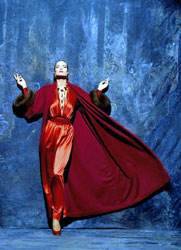 o Hubert de Givenchy himself presents an exhibit at the Museum of Lace and Fashion ~ 70 priceless outfits from private collections, House of Givenchy, and museums in Europe, designed by the master of haute couture now 90 years of age. At the Cité de la Dentelle de la Mode, 135, quai du Commerce, Calais, France. June 15 to December 31, 2017. More information at cite-dentelle.fr. o Pompidou Metz will host an exhibit Fernand Léger, Beauty is Everywhere in honor of the 40th anniversary of the Centre Pompidou in Paris. Pompidou Metz is located at 1, Parvis des Droits de l'Homme, Metz, France. Further details can be found at the museum's web site: http://www.centrepompidou-metz.fr/ 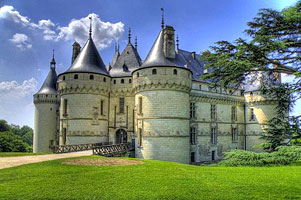 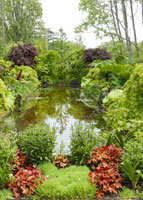 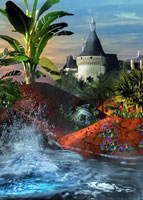 o The 26th annual International Garden Festival, Flower Power (Le Pouvoir des Fleurs), will run until November 5th at Château de Chaumont [photos right], well-known as the home in exile of the mistress of Henri II, Diane de Poitiers. For information visit www.domaine-chaumont.fr o The French Open at Roland-Garros is now taking place and ends on June 11. Visit www.rolandgarros.com. o The 24 Hours of Le Mans, held each year since 1923, is still the world's oldest endurance championship. This year it will be on June 17, with more information at www.lemans.org. o Pissarro in Éragny are shows not to be missed. This great Impressionist painter was known for his kindness and was a mentor for painters younger than himself. There is currently a retrospective of his work at the Musée Marmottan; concurrently an exhibit is being held at the Musée du Luxembourg focusing on the last 20 years of his life. Pastoral settings around Éragny inspired much of this work. Until July 9, a day before what would have been his 187th birthday. Details at www.museeduluxembourg.fr.
DID YOU
KNOW? The King
Louis XIX was the king of France for only about 20 minutes?
He ascended the throne upon the abdication of his father Charles X in July of 1830, and then abdicated twenty minutes later in favor of his nephew the Duke of Bordeaux. In the US . . . o Frédéric Bazille and the Birth of Impressionism is at the National Gallery of Art in Washington, DC, until July 9th, The NGA has teamed up with the Musée Fabre in Montpellier, France, and the Musée d'Orsay in Paris to explore the work of French painter Frédéric Bazille (1841-1870), who claimed an outsized, if often overlooked, influence on Impressionism. He was born into a wealthy Montpellier family, and began painting while attending medical school in Paris. When he failed his exam, he began painting full time, was a friend of Monet, Renoir and Sisley and was very generous giving studio space and materials to artists around him. He joined to fight in the Franco-Prussian war one month after it began, and was killed at the age of 28 in the Battle of Beaune-la-Rolande. There are some 75 paintings in this show of this talented young artist. More information at their web site.o Boston: Matisse in the Studio at the Museum of Fine Arts until July 9, 2017. A broad selection of the famous Fauvist’s paintings, sculptures, and drawings, set in the context of his 'studio collection' ~ the objects with which he surrounded himself for inspiration while at work (decorative arts and textiles from all over the world) ~ promises to give a palpable sense of the diverse sources of his work. For details click here. o The National Gallery of Art from now until August 20th will host America Collects Eighteenth-Century French Painting, featuring some 70 paintings by the likes of François Boucher and Jean-Honoré Fragonard from public collections around the country. The show will tell the story of the collectors, curators, museum directors, and dealers responsible for developing an American appetite for the French rococo and neoclassical styles. Further information at http://www.nga.gov. o The Dallas Museum of Art has an extensive permanent collection of European art ~ see the second floor European Gallery ~ with many works by a wide variety of French painters and sculptors. To see upcoming exhibits and learn more about the museum's collection, visit https://www.dma.org/. o In a coup for the new Denver Art Museum, officials recently announced that the museum will be the only place in the United States hosting a new exhibit that looks at the evolution of French painter and sculptor, Edgar Degas, famous for his prolific output and impact on the art world. Degas: A Passion for Perfection will run from February 11 to May 18, 2018, following its debut at the Fitzwilliam Museum at the University of Cambridge in England. The Denver exhibit will include more than 100 works completed between 1855 to 1906. There will be additional works by Delacroix, Ingres and Cézanne. More information available at http://denverartmuseum.org. [adapted from a Denver Post article by John Wenzel] THE BOOKSHELF - Les Parisiennes by Anne Sebba
From the moment you begin reading Les Parisiennes - How the Women of Paris Lived, Loved and Died Under Nazi Occupation, you realize that you never knew this side of World War II. Truth be told, there are few outside of France who knew, including the French men who were away fighting. All the movies and books written didn't tell how the women of France, and Paris in this case, were left behind to manage ~ to manage their lives and their children, to find food when it was being confiscated by the occupying army and sent to Germany, to earn money when many of them never worked before or wouldn't be permitted to work now. Fear and hunger were things they faced every day, not knowing who to trust or where to turn for help. The author, Anne Sebba, a former Reuters foreign correspondent, spent endless hours, days and months interviewing survivors, often rushing to meet those who might not live much longer to tell her their story. She tells us how pleased the occupying army was to be in Paris ~ a city they had heard so much about but probably would have never seen had it not been for the war. She tells us how the officers and their wives made good use of the expensive restaurants (they would make sure food was still available in those places), and how the upper class French in the city managed to continue with their lifestyles as well ~ at least during the first few years. A lot of names of women are provided, some unknown to us and other quite famous. At first, its seems that more names are mentioned than we will be able to remember, but as we read on those people reappear over and over again, so we can follow them from 1940 until the war has ended ~ or until they die. Edith Piaf continued her singing career which flourished in the nightclubs frequented by Germans. She registered with their propaganda department, had her lyrics checked and kept on good terms with the Nazis. But, she also used her popularity to help her friends, and her most risky act was to perform in prisoner of war camps in Germany. She cleverly had herself photographed with dozens of prisoners during her visits. She gave those photos to the Resistance who used the images to create as many as 120 false identity cards to help those same prisoners escape. The fashion designer Coco Chanel closed her shop when the war began and lived at the Ritz Hotel with her German lover. She was arrested and questioned by the FBI in 1944 because of her relationship with Hans Günther von Dincklage, a suspected spy, but she was quickly released ~ some think Churchill had something to do with her release as she kept in touch with him asking for help to release her nephew and regarding other issues. Or, he may have aided in her release due to her affair ten years earlier with his good friend the Duke of Westminster. Although she was never charged with treason, her willingness to consort with Germans and her tirades against Jews made many think that she was very lucky to escape punishment. She was hopelessly addicted to opium, and had been for a very long time, which did not serve her well as she grew older. Probably more interesting were the tales of horror, deprivation and helplessness experienced by the average Parisian woman. Each struggled as the war raged on to find any kind of food at all. Some grew vegetables in window boxes at their apartments. Many shipped off their children to relatives in the distant countryside hoping they would be safe there and have something to eat, although crossing into "free France", where Marshal Pétain and his Vichy government were in charge, was nearly impossible. Some managed to do it, but soldiers were closely watching for violators. Things became much worse when the Gestapo came to town, although it is hard to imagine that anything could really become worse. There is so much more to Les Parisiennes, and the author is never judgmental about any of the women involved. It would be easy to condemn those who cooperated with the enemy, but people did things they would never have done in peacetime. The women who were judged collaborators following the war paid a price. During the war those considered conspiring against the occupiers or helping the Resistance were sent off to camps, treated very cruelly and so many of them died. It was a no win situation, but the women endured as best they could with all of their men away at war. It is a compelling and moving account of what it was like inside occupied France, and it should never ever happen again. Les Parisiennes - How
the Women of Paris Lived, Loved and Died Under Nazi Occupation
is published in the US by St Martin's Press, New York and by Weidenfeld & Nicolson in Great Britain Copyright 2016 by Anne Sebba ISBN 978-1-250-04859-2 (hardcover) and ISBN 978-1-4668-4956-3 (e-book) Order Les Parisiennes by clicking on the Amazon banner. FROM SOCCA TO FOIE GRAS by Kim Defforge When thinking of the French Riviera, Nice in particular, the senses become engaged: the sight of the azure Mediterranean Sea, the sound of the waves softly lapping the shoreline, the feel of the pebbles underfoot as you walk on the beach, the smell of the salty sea mist in the air, and mostly, the taste of local specialties, such as salade niçoise and socca (a pancake made from chickpea flour and served warm with black pepper). With a Mediterranean climate and average of 300 days of sunshine, the area is indeed attractive and booming. When thinking of the Dordogne region, Sarlat in particular, the senses become equally engaged: the sight of medieval architecture and castles, the sound of market vendors selling their wares, the feel of cobblestones underfoot as you walk through the historical center, the smell of countryside air, and mostly, the taste of local specialties such as foie gras (duck liver that originated in ancient Egypt around 2500 BC and now is emblematic of French gastronomy) and black truffles (an edible fungus that averages 500-1000€ per kg). With the variety of four distinct climatic seasons, the area is a kaleidoscope of landscape colors. Both places are famous for their cultural activities that attract tourists from far and wide, especially the outdoor markets promoting local produce and regional specialties: Cours Saleya in Old Nice and Place de la Mairie in the historical center of Sarlat. Tourism is vital to both: Nice has a population of approximately 340,000 and attracts an average of 5,000,000 visitors a year, while Sarlat’s population is around 10,000 with an average of 1,500,000 visitors per year. Due to its smaller size, the town of Sarlat has a more drastic decline in visitors than the city of Nice during the winter months, not to mention overall colder temperatures, yet both host cultural events to attract tourists during the low season. 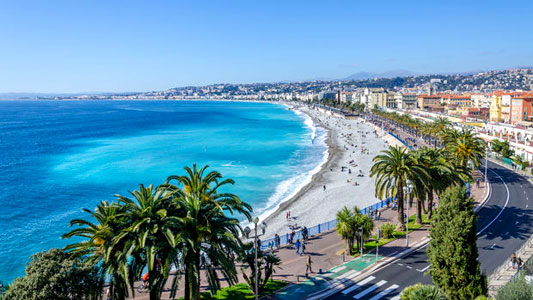 Trivia
& Tidbits: Trivia
& Tidbits:Nice
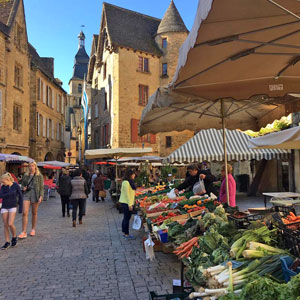 Sarlat Sarlat
As for ambiance, while living in Nice, I woke up to the cacophony of cars, buses, and pedestrians, inherent with city living and its hustle and bustle of activity. Compare that setting to Sarlat, where morning birdsong and the sound of an occasional car passing by is the norm – a matter of urban vs. rural setting, each with its pros/cons & sounds: Chacun à son gout (to each his own)! After living nine years on the French
Riviera, Kim now resides
in the Dordogne.
Owner of Manoir Fontaine de l'Amour with its fully-equipped, holiday rental apartment, she is ready to welcome you to the medieval town of Sarlat. Visit her 24/7 in France blog at https://twentyfourseveninfrance.com/
SPONSORING
THIS ISSUE: CHÂTEAUX FOR SALE
Château Castell
Rose
Château
Rhodes
Château de
Chanzé
The
three châteaux above are currently
for sale.
Château Castell Rose is in the south of France near both the Mediterranean and the Spanish border. It offers guest rooms in the château and three air-conditioned gîtes on the property. Great views of the Pyrénées Mountains, a swimming pool and tennis court, too. Château Rhodes is a completely renovated elegant property in the Ariège of southern France with a professional kitchen, swimming pool and tennis court set on twenty acres. It is convenient to Toulouse and the airport. In the Loire Valley on the banks of a delightful river is Château de Chanzé. This historic property was just updated, and in addition to the rooms in the Medieval château, it has several gîtes, air-conditioned chambres d'hôtes, a large communal room, a swimming pool and an underground wine cave. Click on the photos to read more, and then contact us to answer your questions.
|
 previous
page
next page
previous
page
next page  |